How to adjust winx house plastic windows yourself. General information about adjustment. How to adjust windows according to the season
Plastic windows have come into use for a long time and are not going to give up their positions primarily because of their reliability and practicality. Despite this, over time, their functionality may be impaired.
Do not get upset and look for a specialist to troubleshoot problems in the operation of metal-plastic structures. Adjusting plastic windows yourself is quite real.
It is only necessary to study some of the features of the defects that have arisen and the technologies for repairing PVC windows. Let's try with the help of this article to help understand the question of how to adjust the plastic structure. Detailed instructions for adjusting and repairing plastic window mechanisms will be presented here.
Types of violations of PVC structures
How to adjust plastic windows independently, and what problems can be fixed without involving specialists? Such violations of the functionality of a plastic window include:
- the window sash catches the frame;
- the sash does not close tightly;
- strikers are worn out;
- the structure does not close, as the handle is blocked in the open state;
- the handle does not turn when the sash is closed;
- the handle is out of order;
- the handle doesn't turn well.
To adjust plastic windows, you will need some tools:
- pliers;
- hex key size 4 mm;
- screwdrivers of various types.
Basic requirements for window adjustment
![]() Hex key for adjustment
Hex key for adjustment
You can adjust the plastic window in several directions. With the help of this feature, you can adjust the operation of the structure along the frame, as well as control the degree of its pressing.
The technology for adjusting plastic windows is basically the same, apart from minor differences in the arrangement of fittings from different manufacturers. Now imagine more detailed instructions for adjusting plastic windows for certain defects in work.
The sash catches the frame from below
 If the sash catches the frame from below, then the structure has sagged.
If the sash catches the frame from below, then the structure has sagged.
After some time of functioning of PVC windows and doors, there is a hook on the frame sash. This fact suggests that the structure had time to sag.
With such violations, adjustment of the upper hinge of the plastic window is necessary. When eliminating defects in the operation of the window sash, it is necessary to move it towards the upper hinge and from the bottom up, thus eliminating the sagging. The adjustment scheme is as follows:
- First, let's open the fold.
- We adjust the adjusting screw, which is located next to the upper hinge at the end of the sash. Perform this process with a hex key that is turned clockwise.
- On the lower loop, the cap is removed and with the key we perform a couple of turns clockwise.
- We check the degree of adjustment of the valves, and if the defect cannot be completely eliminated, we perform these actions until the desired result.
The fold catches the frame on the side
 Adjust the screws with a hex wrench
Adjust the screws with a hex wrench
Opening a PVC window when the sash touches the frame causes problems. The window device will not be able to open and tilt freely. Do-it-yourself window adjustment in the case when the sash clings to the frame from the side is carried out according to the following algorithm:
- when the frame sash is hooked only from below, it is necessary to move it towards the loop in its lower part. This is achieved with the adjustment screw, which is located under the bottom loop;
- when the sash is hooked around the entire perimeter, it is necessary to adjust the screw, which is located at the end of the sash next to the upper hinge.
Setting the strike frame
 From time to time it is necessary to check the operation of the striker plate. Their number is usually as follows: one plank from all sides around the entire perimeter.
From time to time it is necessary to check the operation of the striker plate. Their number is usually as follows: one plank from all sides around the entire perimeter.
Self-adjustment of plastic windows is needed if you notice wear of at least some striker plate. This may mean that the device has sagged. How to correct this shortcoming? You can do this with the following actions:
- Slightly open the structure and remove the special plugs from the hinges, and with the help of the key we begin to loosen the bolts.
- We proceed to adjust the upper part by adjusting the screw so that the frame is adjusted horizontally and then vertically. The vertical position of the window is adjusted using the lower hinge screw.
In order to control whether the setup process is going on correctly, you need to constantly open and close the structure. If the sash can open and close freely, the process is complete.
Setting the tightness of the sash
 The trunnion regulates the pressing force of the sash against the frame
The trunnion regulates the pressing force of the sash against the frame On the side at the end of the sash, at the location of the handle, there is a system of eccentrics or, in other words, trunnions. With the help of them, the pressure of the plastic window is adjusted. The clamp of the structure ensures the absence of drafts.
Each manufacturer appearance eccentrics is different, but the principle of operation is similar. Pin adjustment on plastic windows is done with pliers. To do this, turn them a few turns.
The degree of pressure of the valves in summer and winter is different. In the warm season, the pressure should be weaker than in the cold season. In winter, in order not to blow, the sash should fit snugly.
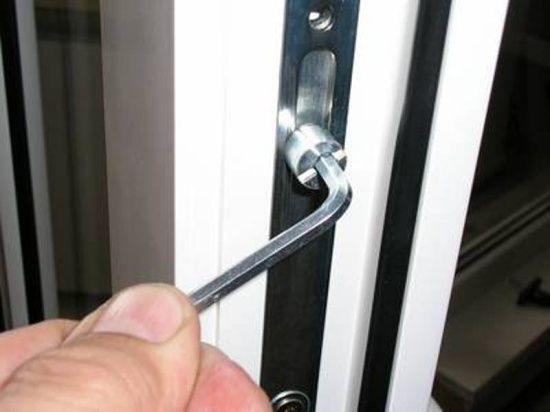 The pressure can also be adjusted from the hinge side by turning a special screw in the lower hinge. Particular attention should be paid to the tilt-and-turn sash. Setting up the folding mechanism is a more time-consuming process.
The pressure can also be adjusted from the hinge side by turning a special screw in the lower hinge. Particular attention should be paid to the tilt-and-turn sash. Setting up the folding mechanism is a more time-consuming process.
In this case, you need to adjust the pressure using the screw in the top hinge. The mechanism is located near the loop at the top. To use it, you need to slightly open the sash, then, pressing the lock, place the handle in the ventilation mode.
You can correctly adjust the screw as follows: when increasing the degree of pressure, the screw is rotated clockwise, when loosened, vice versa - counterclockwise. Do not forget during the setup process to check the operation of the swing-out sash.
We adjust the fittings
 Let's start adjusting PVC window fittings. Basically, screwdrivers and a hex wrench are used for these purposes. The knobs are mostly adjusted with screwdrivers and the strikers with a hex wrench. If the sash is poorly pressed, then the bar is shifted towards the street.
Let's start adjusting PVC window fittings. Basically, screwdrivers and a hex wrench are used for these purposes. The knobs are mostly adjusted with screwdrivers and the strikers with a hex wrench. If the sash is poorly pressed, then the bar is shifted towards the street.
The degree of pressure is also adjusted from the side of the hinges, where the mechanism adjustable with a hex key is located. The degree of pressure is set using the tongue. The more it extends, the better the sash will be pressed. Consider other cases when you need to adjust window fittings. For adjusting the sash pressure, see this video:
Setting a handle that is locked when the sash is open
 Eurowindow fittings work in such a way that when the structure is opened, the handle does not turn to the “closed” position. For this, special locks are provided in the fittings mechanism.
Eurowindow fittings work in such a way that when the structure is opened, the handle does not turn to the “closed” position. For this, special locks are provided in the fittings mechanism.
With certain violations of the functioning of the handle, a situation may arise when the handle is turned in the “closed” position, and the structure is open. That is, the blocker fixed the position of the handle. To correct this situation, it is necessary to press the blocking device and turn the locking mechanism to the “open” position.
The handle does not turn
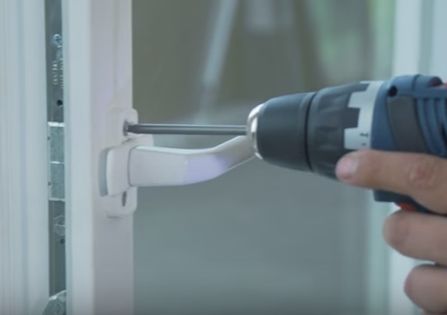 How do you adjust plastic windows with your own hands in case of problems with the handle? It jams or it is impossible to turn it.
How do you adjust plastic windows with your own hands in case of problems with the handle? It jams or it is impossible to turn it.
With such a defect, the process of coupling the locking mechanism with the mating element is not performed. This problem is solved in two ways:
- the sash is displaced with the help of an adjustable screw to the response mechanism;
- the fastening is loosened and a plate of dense material is inserted between the sash and the frame.
Handle broke
 If the handle is out of order, then you can repair plastic windows with your own hands. Repair begins with the fact that the mechanism of the locking device is released by removing the lining.
If the handle is out of order, then you can repair plastic windows with your own hands. Repair begins with the fact that the mechanism of the locking device is released by removing the lining.
To do this, you need to pull it back a little and turn it 90 0. Next, unscrew the fasteners that hold the device, and mount a new handle in its place. For more information on adjusting the handle, see this video:
The handle doesn't turn well
 It is not always necessary to mechanically adjust the fittings of plastic windows. For example, the poor functioning of a plastic window handle is mainly due to poor-quality lubrication of the mechanism.
It is not always necessary to mechanically adjust the fittings of plastic windows. For example, the poor functioning of a plastic window handle is mainly due to poor-quality lubrication of the mechanism.
- Check seals regularly to prevent wear.
- When removing all plugs, work should be done very carefully so as not to spoil their appearance.
- If there is a deformation of the frame, then you will not be able to adjust the windows yourself. In this case, you will have to turn to specialists. It is better not to repair PVC windows with your own hands.
An important factor in the long-term functioning of metal-plastic structures is the installation of products from generally recognized manufacturers. For example, install Rehau windows at home, the quality of this product has been tested for years. For more information on adjusting PVC windows, see this video tutorial:
In order to avoid the appearance of defects in the fittings of plastic windows, lubrication of all rubbing parts should be carried out regularly.
Adjusting the fittings so that the window closes tightly and opens easily is not difficult.
Adjustment of plastic windows is almost always included in the basic list of services offered by window companies. But the proposal is one thing, but how it is implemented in practice is completely, completely different. So it is better to acquire a minimum set of knowledge and skills for “setting up” the window mechanism in advance, so that if necessary, you can fix minor malfunctions with your own hands.
General information about adjustment
Why is this operation necessary?
A PVC window is a rather complex structure, the functioning of which is ensured by a special mechanism - fittings. Thanks to the operation of the fittings, the window sash opens in different positions, and, if necessary, can be pressed against the frame along its entire perimeter.
The reverse side of this functionality is a certain "capriciousness" of the mechanism. During the entire period of operation, the fittings (both locking parts and hinges) experience significant loads. As a result, the sash does not open (or close) as it should, and we have to figure out how to adjust the plastic windows.
The main tasks that the setting of PVC window fittings solves:
- Selection of the optimal clamp. Sometimes for summer and for winter time it is recommended to choose a different clamping force. Provided in summer natural ventilation(plus the seal "rests" a little), in winter - maximum tightness. This can be achieved by adjusting the pressure rollers.
Adjusting the pressure of the sash to the frame is one of the most controversial issues. Experts in the window industry are divided into two camps: some consider this operation almost mandatory, others argue that this does not give much effect. In many ways, I tend to the second option: you need to take on changing the pressure around the perimeter only if this allows you to solve some kind of problem. For prevention - do not!
- Blowout elimination. Loose clamping of the sash to the frame can be caused either by its warping or poor-quality work of the locking pins. In both cases, blowing can be eliminated by adjusting the position of the sash using the hinges.
- Elimination of distortion. A sash with a double-glazed window is a rather heavy structure, and therefore even a strong hinge deforms over time under its weight. As a result, the design warps, which leads to problems with opening and closing, as well as jamming of the locking mechanism. There are two ways to correct the position of the sash: either by correctly wedging the double-glazed window, or by correcting the position of the hinges.
In principle, all three tasks can be solved by trial and error: the design of loops and other elements allows this. But it is much better to use the instructions given: this way, setting up the fittings will be more efficient and take less time.
What do you need to work
Sash adjustment plastic windows is not the most difficult task. For its implementation we will need:
- The 4mm hex wrench is the most important tool.
It is better to take several keys of different configurations - it will be easier to choose the most convenient option for a particular screw.
- Phillips screwdriver.
- Staple knife.
- Plastic hammer for glazing beads.
- Shovel for double-glazed windows.
- Rags for cleaning accessories.
- Linings for glass
- Lubricant for fittings in an oil can or aerosol.
In addition, I would advise you to download the documentation package from the hardware manufacturer. Of course, below I will give instructions for performing the most important operations, but it describes the general sequence of actions. At the same time, some fitting systems may have their own peculiarities of functioning and settings. So in the question of how to adjust plastic windows, it is advisable to focus primarily on the opinion of the manufacturer.
Adjustment technology
Operation 1. Summer and winter operation of fittings: clamping adjustment
The first task that should be solved is the choice of the optimal clamp. I noted above that it is better to focus on Golden Rule- "If it's not broken, don't fix it!" Simply put, do not worry about the pressure - and good!
If the sash blows around the entire perimeter, and this creates discomfort, you need to increase the force of the pressure roller. The price of the services of a master regulator will be rather big (in Moscow it can reach up to 500-700 rubles per sash), so you should learn how to cope on your own.
Pressure adjustment method:
| Illustration | Operation description |
 | Preparation.
|
 | Determining the pressure level. Pay attention to the locking pins. Most fitting systems have special marks on these parts. In the neutral position, the mark should be at the top of the pinch roller. |
 | Summer pressure setting.
|
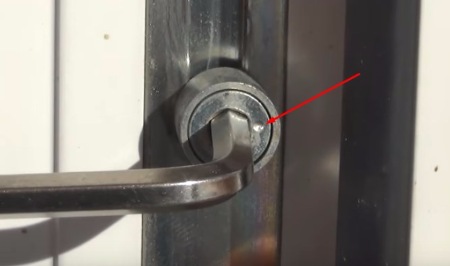 | Installation of winter clamp.
|
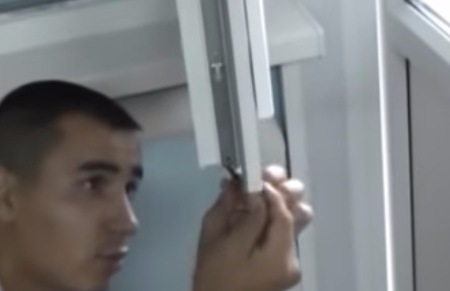 | Adjustment of all points. We repeat the desired operation for all locking pins around the perimeter of the window. |
Operation 2. Elimination of sagging sash
You can also adjust plastic windows if the sash sags under its own weight. The “symptoms” of sagging are, first of all, the lower edge of the structure touching the frame when closing and problems when turning the handle. The problem is solved either by adjusting the hinges or by moving the double-glazed window inside the sash.
Instructions for eliminating sagging:
| Illustration | Operation description |
| Loop adjustment | |
 | Determining the offset direction.
|
 | Providing access to screws.
|
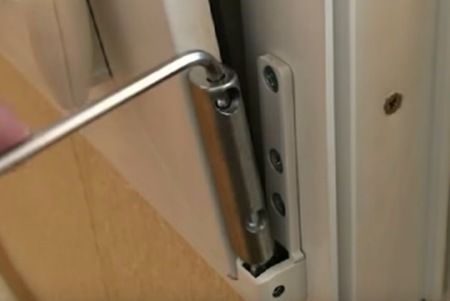 | Raise the sash vertically.
|
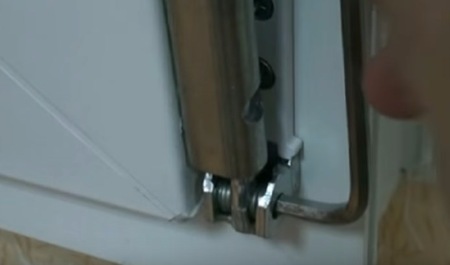 | Bottom corner clamp.
|
 | Top corner clamp.
|
| Wedging the sash | |
 | Removing staples.
|
| Determining the location of the skew. We examine the double-glazed window in the sash. As a rule, the problem with displacement appears where the double-glazed window is pressed against inner surface profile. This happens when the sash sags under its own weight. The most common case is a clamp in the upper corner on the opening side. |
|
 | Raising the sash.
|
 | Breaking the package.
|
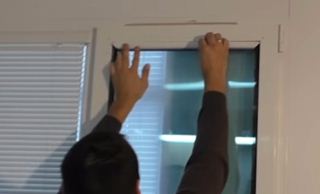 | Installation of glazing beads.
|
We control the quality of alignment: it is enough to open the sash, setting it perpendicular to the window. If we set the fittings correctly, the sash will neither slam shut nor swing open under its own weight.
If the sheet sandwiched between the frame and the sash is easily pulled out - in this place you need to increase the pressure
In some cases, when the sash is skewed, the window does not close completely, and local areas of blowing are formed along the perimeter. These gaps can be repaired with minimal effort.
We fight with blowing around the perimeter like this:
| Illustration | Operation description | |
 | Finding a problem area.
|
|
 | Loop adjustment. To begin with, we perform the usual adjustment, eliminating the skew by turning the hinged screws. It helps about half of the time. |
|
 | Removing the backplate. Where the clamp is insufficient, remove the reciprocal bar. This is done simply: just unscrew the fixing screw with a Phillips screwdriver.  | Installing the back plate.
|
After completing all the adjustment operations, the fittings (or better, the seal) should be lubricated. This will facilitate the operation of the system and reduce its wear: when the misalignment is eliminated, gaps will appear between the parts, and lubrication in these places will obviously not be superfluous.
Conclusion
Everyone can learn how to adjust plastic windows on their own if desired. It is enough to follow the recommendations in the text and in the video that I have selected for this article, do not rush and control the result of each operation. If at any stage you have any difficulties - you can always get advice in the comments!
« – Tell me, do you make double-glazed windows on parole?”
Glad to meet you, dear readers!
Almost all my friends and relatives have double-glazed windows installed in their apartments. They were installed, in general, recently, let's say from 3 to 8 years ago. The topic of the article was "pushed" by a friend who encountered a problem in their operation. So, today I’ll tell you about how to adjust plastic windows on your own and not call the wizard.
I think that the topic is no longer relevant for you. After all, you have already installed them and “acquired some” worries. Let's start slowly...
- The window sash, when closing or opening, touches the profile or fittings;
- An invigorating breeze draws from the “tightly” closed window;
- The handle has become loose or vice versa, it has become uncomfortable tight;
- After opening the window, the handle suddenly jammed.
There are others, but these are typical.
I will say right away that there are problems that have arisen due to a violation of the basic technology in the manufacture or installation of the profile. Are windows adjustable in such cases? Not always. One positive point - these problems usually appear immediately, and on a "fresh occasion" you can always call a representative of the seller (installer). Some "experienced" firms begin to "search" for the cause of the repair, in improper operation.
A necessary tool for self-adjustment
- Hex key 4 mm (it is also called "furniture", it is usually L-shaped);
- Screwdriver with a set of nozzles that look like "asterisks" (marking TX or T);
- Phillips screwdriver (size 3 or 4);
- pliers;
- Spray WD-40, silicone grease, or regular automotive oil;
- Spatula for lifting a plastic window;
- Spatula, rubber mallet and brush.
Before we move on to the main issue, let's define a narrow-profile glossary. Among experts, those parts that are on the sash are called the “Locking Mechanism”, and those on the frame are called “Answers”. It seems clear and logical. On fig. 1 shows the locations of the main elements, contact with which will allow for adjustment (debugging).
Do-It-Yourself Basic Troubleshooting
The operating modes of plastic windows of most manufacturers are regulated, as a rule, in three planes. In general terms, the operation of the fittings looks as shown in Figure 2. For an example of practical actions, I will further cite photographs of the Veka (VEKA) and Rehau windows.
Let's consider specific situations.
1. When we close the sash, it touches the frame from below
In this case, it is necessary to lift the sash in the direction of the upper hinge upwards.
Our actions:
1.1. We must open the window;
1.2. Then we turn the adjusting screw located near the upper hinge at the end of the sash with a hex wrench. Rotation is clockwise (see photo 1)
 Vertical adjustment photo 1
Vertical adjustment photo 1 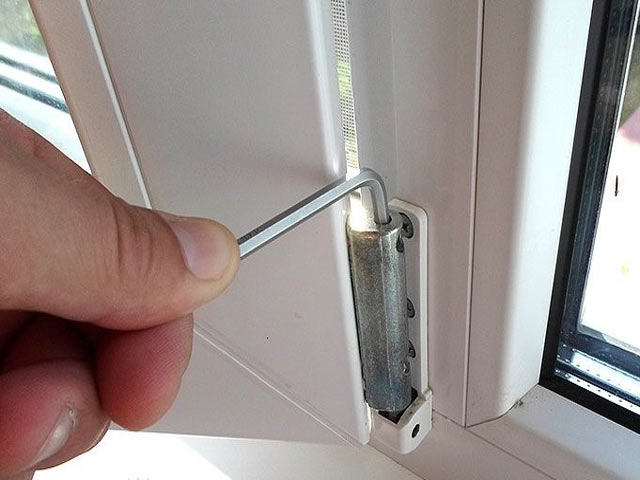 Photo 2
Photo 2
1.3. We close the sash;
1.4. We remove the plastic decorative cap from the bottom loop (slight upward movement);
1.5. We insert the hexagon into the adjusting screw of the loop and turn it clockwise several times;
1.6. We try the window sash for a free easy move. If necessary, we adjust until the defect is eliminated (photo 2.)
2. When closing, the sash hits the side of the frame
Here it is necessary to move the sash towards the hinges. In a word, a horizontal offset is required.
2.1. If the side surface of the frame touches the window opening only from below, then it is enough to take it away in the direction of the lower hinge. This is easy to do using the adjusting screw, which is located under the bottom loop (photo 2)
2.2. In the case when the sidewall of the sash touches the frame along the entire height, it is necessary to move the sash towards the upper hinge, as indicated in photo 1.
“Will I be cold in winter? (Question of the buyer who ordered two windows by self-delivery and without installation).3. The window sash is not tight enough to the frame
On each window, from the end of the sash, there is a so-called eccentric system. Its purpose is to adjust the pressure density. Different manufacturers of accessories produce different designs and sizes, but the principle of operation is the same for all.
3.1. Gently rotating the eccentrics with a hexagon or pliers (of course, a hexagon is better), adjust the desired tightness of the sash to window frame;
"IN summer time year it is better to do a weak pressure, for the winter - a stronger one.
3.2. If it is required to adjust the tightness of the sash pressing against the window frame from the side of the hinges, this is done using the adjusting screw, which is located in the lower hinge.
If the sash is tilt-and-turn, then additional adjustment is possible using the top hinge. To get to the adjusting bolt located next to the upper hinge, you need to open the sash, after which, after pressing the blocker, set the handle “for ventilation”.
If you need to press the sash against the window frame, turn the screw clockwise, if you need to loosen it, respectively, against it.
 Pin adjustment photo 3
Pin adjustment photo 3  We adjust the fit of the sash photo 4
We adjust the fit of the sash photo 4
Some accessories are regulated only with the help of "answers" located on the side of the handles. The position of the "responses" is regulated by a hexagon. To increase the density of pressing the window sash to the frame, move the bar to the side of the street. On the frame (on the hinge side) there are clamping mechanisms. They are also adjustable with a hexagon. The more the tongue extends, the stronger the pressure on the sash and frame.
4. Locking the handle in the "closed" mode
Lock Closed
In this case, the sash is open, but the window cannot be closed.
"Important! The handle can only be manipulated when the sash is closed.
In order to avoid its accidental rotation, there are blockers that are located at the end of the sash (near the handle). They are different kind and designs. It all depends on the hardware installed. To unlock the handle, simply press down on the lock. Everything is done...
5. The window does not close in any way
Horizontal adjustment
At the same time, the sash is pressed, but the handle does not want to turn.
Reason is here: “communication does not work” between the blocker and the response mechanism on the frame itself. To fix the problem, there are two options:
5.1. Turning the adjusting screw, which is located under the lower loop. It is necessary to slightly shift the sash in the direction of the response mechanism of the blocker;
5.2. Slightly loosening the mount, you need to insert a thin but strong plate between the counter element of the blocker and the plastic frame.
6. Handle broke
6.1. Gently pull the handle trim towards you and rotate it 90°.
6.2. Find under the overlay. Unscrew them and remove the broken handle. Install the new handle in reverse order.
 Change the handle
Change the handle  Lubricant WD-40
Lubricant WD-40
7. The handle is too tight to turn
common cause- lack of lubrication. The solution is to lubricate the mechanisms. What to apply? WD-40, silicone grease or machine oil will do just fine.
Good windows are those that are regularly serviced. Check rubber and silicone seals annually. If necessary, change;
- - carefully remove the plastic decorative elements. They are quite "flimsy";
- - if the window frame or opening is deformed - call a specialist. On your own, you won't be able to;
- - there are doubts that you can’t fix the problem on your own - call a specialist.
That's all for now. In this article, I tried to highlight the most popular and common situations. But do not think that nothing else will happen ...
From the customer's dialogue: “- A five-chamber double-glazed window and a two-chamber frame are required. Or vice versa… – single-chamber double-glazed window and two-chamber profile. Or ... In general, with winter ventilation.
Conclusion: if you don't know what you want, you don't know what you'll get.
I hope this information was informative. If yes, then subscribe to the blog for news and recommend to friends on social networks.
Good luck and tight, warm windows in winter! Bye! Bye!
Wisdom Quote: Any question can be answered if the question is asked correctly..
Adjusting a plastic window on your own is not so difficult, you just need to know some of the subtleties and features of their device, without knowing these things, difficulties arise.
In this article, we will try to talk in detail about solving the problems that arise with plastic windows, and provide as detailed as possible instructions on how to properly adjust plastic windows.
To carry out self-adjustment of the PVC window, you will need a 4 mm hex key, the so-called "four".
 Let's start with horizontal adjustment plastic windows. For its implementation, the upper and lower hinges are used, each of which has a special hole for working with a hex key. The top loop is adjustable after opening. The sash is attracted to the hinge while rotating clockwise with a hexagon. The bottom of the window, which is opposite the hinge, will rise slightly.
Let's start with horizontal adjustment plastic windows. For its implementation, the upper and lower hinges are used, each of which has a special hole for working with a hex key. The top loop is adjustable after opening. The sash is attracted to the hinge while rotating clockwise with a hexagon. The bottom of the window, which is opposite the hinge, will rise slightly.
If the hinge needs to be moved away from the sash, then the key, respectively, should be rotated counterclockwise. With this rotation, the bottom will drop slightly. Adjustment of the lower hinge from the inside is carried out with open window, from the outside - when closed. The adjustment itself is carried out in a similar way. Adjusting the window in the horizontal plane can move the frame up to two millimeters and eliminate the bevel.
The vertical adjustment of the window is carried out using the lower hinge. The hexagon, which is used for adjustment, is located under the cap covering the loop. Turning the hex clockwise will raise the window, counterclockwise will lower it. Vertical shift of the frame to eliminate the bevel is also possible up to two millimeters.
 The gate clamp is regulated by means of eccentrics; they are located along the perimeter of the window. By turning the handle, the adjuster forces the eccentrics to go beyond the pressure pads, which are also located along the perimeter. Turning the eccentric clockwise adjusts the density of the window pressing against the frame, counterclockwise - loosening the pressing. On the surface of the eccentric there is a risk to determine the degree of pressing the window to the frame. The direction of the risks to the seal indicates a strong pressure. If the risk is directed to the outside (to the street), then the clamp is loosened.
The gate clamp is regulated by means of eccentrics; they are located along the perimeter of the window. By turning the handle, the adjuster forces the eccentrics to go beyond the pressure pads, which are also located along the perimeter. Turning the eccentric clockwise adjusts the density of the window pressing against the frame, counterclockwise - loosening the pressing. On the surface of the eccentric there is a risk to determine the degree of pressing the window to the frame. The direction of the risks to the seal indicates a strong pressure. If the risk is directed to the outside (to the street), then the clamp is loosened.
Some cams can be rotated using pliers or a wrench. Sometimes there is also a clamp with plates located on the window sash. A special clamping mechanism is located on the side of the hinges, it is regulated using a hexagon. With a strong pressing of the window to the frame, the tongue on the sash is significantly extended. To extend the tongue, the hexagon is rotated counterclockwise if the window hinges are located on the left side. If the loops are located on the right, then the hexagon is rotated clockwise.
The degree of pressure should be different depending on the season. IN winter time the degree of pressure should be the greatest, and weakened in the summer so that the seal does not wear out. Pressure adjustment is possible by 0.8 mm.
![]() Adjusting the buttonhole pressure is possible for both buttonholes at once, and only for the top buttonhole. It depends on the fittings installed on the window. To adjust the lower hinge, first remove the cap, then rotate the bolt located perpendicular to the window plane. The top hinge is only adjusted for the hinged sashes. The adjusting hexagon is accessible when the window is open and the knob is turned to the ventilation mode. When adjusting the upper hinge, the frame will only be held by the lower hinge and must be held.
Adjusting the buttonhole pressure is possible for both buttonholes at once, and only for the top buttonhole. It depends on the fittings installed on the window. To adjust the lower hinge, first remove the cap, then rotate the bolt located perpendicular to the window plane. The top hinge is only adjusted for the hinged sashes. The adjusting hexagon is accessible when the window is open and the knob is turned to the ventilation mode. When adjusting the upper hinge, the frame will only be held by the lower hinge and must be held.
On some plastic windows there is a lock to prevent the window sash from tilting when it is in the open position. Blockers are made in the form of a lever or a clip. If you want to tilt the plastic window in the open position, you should press the lock and at the same time turn the handle to the ventilation mode.

Problems of plastic windows eliminated by adjustment
- Touching the bottom of the plastic frame occurs due to the sagging of the window sash during operation. Adjustment is carried out either by a vertical or horizontal regulator.
- Touching the frame with the middle sash part is most likely due to the displacement of the sash, vertical or horizontal. It is eliminated by a uniform displacement of the sash in any direction by one of the regulators.
- If it blows from under the seal, then the density of the sash pressure should be adjusted.
- To adjust a loose handle, find the plate in the base, turn it at a right angle and tighten all the screws with a screwdriver. Under the base of the handle, you can also install “combs” - a ventilation regulatory plate.
- When turning the handle hard, simply lubricate its moving parts, including hinges, eccentrics and clamping mechanisms with machine oil or special grease. Clamping pads should also be lubricated with oil. At the same time, use what is at hand - oilers, brushes, cotton swabs.
For those who have not yet acquired plastic windows, I suggest that you read the articles about "" and "".
Modern designs of PVC, metal-plastic and wood windows have special fittings that make the operation of such products very convenient and give it reliability. But, given that any mechanism after some time needs to be adjusted and fine-tuned, you should know some of the nuances that will help keep the state of the windows and their working capabilities in good condition. If you get the hang of it and understand the principle of how plastic windows are adjusted with your own hands, then you can easily and with outside help keep the windows perfect.
Required Tools
In order for the adjustment of plastic windows with your own hands to be carried out without much effort, you must have or purchase some tools. In the process of work you will have to use:
- hex wrench, size 4mm;
- nozzles for an asterisk screwdriver;
- Phillips screwdriver with #3 or #4;
- pliers;
- technical oil or WD40.
With regards to the nozzles that are used for a screwdriver, they will be needed only in certain types of windows, you can basically do without them, but their presence will not hurt, because it is impossible to know in advance that they will be useful without special knowledge of the window view.
The use of a furniture key, which is called a hex key, will be much more convenient if, in addition to its characteristic shape (letter G), it has an additionally curved upper edge, but you can also use such a regular key.

It is impossible to do without a conventional Phillips screwdriver in this case, because all the available parts of the fittings are attached to the retractable window frame with bolts that are designed for a Phillips screwdriver. In most cases, it is necessary to adjust the windows only in roller-type carriages, where the distance necessary for work is set.
In addition to the tool, without which the adjustment of plastic windows with your own hands cannot be carried out, it is better to familiarize yourself with the main adjustment points in advance, this will greatly facilitate the work.

Important: some points of window adjustment will depend on the models and manufacturers of window products, but the principle by which plastic windows are adjusted by hand is similar.
Video - self-adjustment of PVC windows
Possible problems
Of the most common problems that you can fix yourself, there may be those indicated in the table. How to cope with the difficulties that have arisen and adjust the windows with your own hands is indicated for each of the situations.
| Problem | Solution |
| The handle has become unstable | To get rid of this problem, you need to make some manipulations in the mount. The first step is to slightly pry off the top plate of the mechanism, which is usually located vertically on the side of the sash. It is worth doing this with an object made of a fairly soft material, or with your fingers, because you can leave scratches on the plastic. After the plate is slightly raised, it is necessary to turn the handle 90 degrees. After that, 2 bolts that hold the mechanism will be visible, they should be clamped to the maximum possible limit. A screwdriver with a sacral tip will help in this process. After such manipulations, the position of the handle must be checked, making sure that it is permanently attached. |
| The handle needs to be replaced or a fuse installed | In some cases, it may be necessary to change the handle on the window due to the fact that the part has broken off and is not suitable for use, but most often the handle is changed to a special one that has a fuse. This is done in the rooms where children live so that they cannot open the windows themselves. The procedure for changing the handle is very simple, first you need to unscrew the same bolts as indicated in the previous paragraph, and then remove all the contents from the sash. The new element is inserted in a similar position, after which it is fixed with bolts. |
| The handle mechanism jams, or does not fully accept one of the positions | Such a problem is quite voluminous and there may be more than one reason for it. The first reason that leads to such a problem is the need to lubricate and clean the components of the handle mechanism. The second reason may be the wrong level of downforce, which is set on the sash. If the cause of such a breakdown was the need for cleaning and lubrication, then the bolts in the mechanism that holds the handle should be unscrewed. After that, you need to blunt for disassembly in order to clean and lubricate the interior. To do this, a brush and oil are useful, you can use a vacuum cleaner and remove all dust particles with it. A glass cleaner can also help in cleaning, but you need to make sure that the mechanism does not remain wet after it, and liquid does not get inside the profile. You can lubricate all the components of the mechanism using industrial oil, but it is better to use WD40, which has a special thin tube that allows you to distribute the liquid throughout the mechanism. It is desirable to resort to the use of such a lubricant whenever the operation of the window mechanisms is adjusted. If the handle does not reach the position of the closed state of the window, then it is necessary to adjust the pressing force of the window sash and reduce it. To do this, you need to deal with the regulation of the eccentrics, which are located on the fold of the eye in the same place where the handle is located. Even in this process, loops that are located on the opposite side are important. |
| Handle mechanism jammed | When such a situation arose, it is not necessary to dismantle the handle or replace the fittings, and there is no need to even disassemble and remove the mechanism from the sash. The occurrence of such a problem is due to the fact that the locking mechanism does not work properly, so the window cannot take a position in order to open. In order to get rid of this problem, you need to slightly loosen and move the lever located in the locking mechanism. This lever is located on the side where the handle is attached, at the end. There are two options by which such a mechanism can be designed. This may look like a plate with a tongue, which, in the open position of the window, should be angled in relation to the elastic bands. Another case is a clip located on the seal rubber. |
Leaf deflection
In addition to the problems listed, which are most common, another nuisance can arise if the window is often subjected to sudden closing and opening. With such handling of the product, the fittings in it very quickly lose their original state and all fasteners are loosened, which leads to the fact that the components of the window structure begin to be crooked in relation to each other.
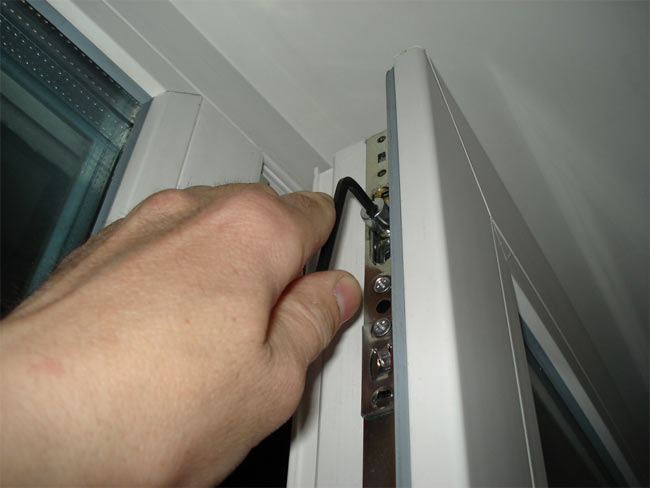
Nothing particularly serious will happen to the window and its fittings, but plastic windows have been adjusted with their own hands, in such a situation it should be as soon as possible. This problem is eliminated by simple manipulations that can be found on the frame of the window structure, this is usually taken care of by manufacturers. The instructions will provide a step-by-step plan for restoring and adjusting the position of the parts of the window, according to its brand. Basically, you need to carry out the following manipulations:
- In case of curvature of the position of the sash in such a way that it presses on the frame from its lower side at the end, it is necessary to change its position in the upward direction, while turning slightly towards the upper mount.
- If middle part at the end where the handle is located, a curvature has occurred, then you need to move the sash in the direction of the canopies. When there are additional curvatures up or down, then a small turn of the sash should be made in the appropriate direction.
- In the event of a curvature in the upper part of the end of the window element, it is necessary to make a slight rotation of the sash to the lower canopy, sometimes it is necessary to completely move the entire structure a little lower.
Additionally, there are a number of nuances that are also important when adjusting plastic windows with your own hands:
- Adjustment of any of the positions of the leaves is usually done using a hexagon and adjusting bolts. These elements are located in the part of the lower canopy, the mechanism of which is also called "scissors".
- In the case of adjusting doors, or a sufficiently massive window structure, it is necessary to resort to adjusting the closer mechanisms, which can be adjusted in a similar way.
- To make the correct adjustment of the "scissors", you must first open the sash of the window or door as much as possible, and then find the side of the mechanism in which the bolt is screwed. With the help of a hexagon, the position of the sash is adjusted.
How to adjust windows according to the season
During operation, the elastic band, which creates a snug fit of the sash, can be deformed, which will lead to the loss of its qualities and properties, due to which the normal level of tightness and sound insulation is lost. This can happen in the off-season, when there is a difference in the temperature level on the street. Accordingly, it is necessary to adjust the plastic windows on time with your own hands so that there are no problems after the change of season.


To avoid such inconvenience, which can cause a defect in window fittings or eliminate it, there is no need to resort to a complete replacement of components. For such purposes, the design of the window system has mechanisms that allow you to adjust the clamping force so that the rubber bands provide a reliable level of window tightness. The following points will help to cope with this task:
- Such a procedure is recommended to be done once a year, especially if the temperature resonance in different seasons is large enough. If such a simple adjustment of plastic windows is made with your own hands, then with its help you can provide enough long-term operation products and prevent rubber seals from wearing out.
- Eccentrics or, in other words, trunnions, which play the main role in this process, are located in plugs, have the shape of an oval. The frame, in accordance with the location of the trunnions, has a mechanism into which these eccentrics fall and take a position depending on the turn of the handle. Depending on the stationary location of some and other elements, a certain level of sash clamping force is created. Accordingly, do-it-yourself adjustment of plastic windows in this part can be reduced to moving the spirit of the components of the mechanism and selecting the optimal position.

Video - switching windows to winter mode
Faced with the adjustment of plastic windows with your own hands in terms of adjusting them for seasonal changes, you should be aware that there may be differences in this process depending on the brand of the window. The differences usually lie in the following points:
- the trunnion may have a characteristic slot, which, when adjusted, must be rotated with a flat-type screwdriver;
- eccentrics can be retracted with pliers, perhaps just by hand, after which it will be possible to scroll them;
- the trunnion can be adjusted immediately, in the place where it is located when scrolling it with pliers.

Important: how plastic windows are adjusted with your own hands can be understood only by trying each of the points in the same sequence as indicated. Especially, you should not try to immediately resort to adjustment and scrolling with pliers, this can lead to a breakdown of the mechanism.

If no method is suitable for adjusting the degree of pressure, then you can resort to adjusting the mechanism, which is located on the frame, into which the trunnions fall when the window is closed. There are two positions for adjustment, after the bolts securing the mechanism are slightly unscrewed:
- a decrease in downforce can be achieved by moving the hooks towards you, i.e. into the room;
- to increase the pressure, move them in the opposite direction.



